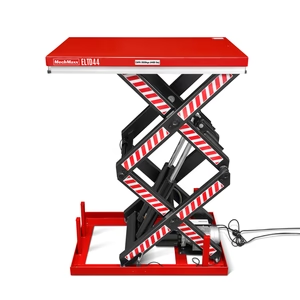Heavy lifting in a workshop or warehouse often means wasted time, strained backs, and safety risks. Whether it’s moving bulky equipment or positioning materials at the right height, using manual methods can quickly become a bottleneck in your workflow.
That’s where hydraulic lift tables come in—they simplify lifting, reduce fatigue, and make operations smoother and more efficient. But with so many types out there, choosing the right industrial hydraulic lift table can be confusing. This guide breaks it all down clearly so you can make a smart, confident choice.
Why Lifting Equipment Matters in Industrial Workflows
Every industrial setting involves tasks that require lifting, positioning, or moving heavy items. Relying on manual effort alone can slow down work, cause injuries, and lead to inconsistent results.
Using proper lifting equipment like a hydraulic lift table helps keep workers safe and reduces physical strain. It also boosts productivity by allowing smoother, faster, and more precise movement of materials. In busy environments like factories and warehouses, a lift table can make the difference between chaotic workflows and organized, efficient operations.
Common uses include:
- Moving heavy boxes between conveyor belts
- Lifting engines or machinery parts during repairs
- Adjusting large components to ergonomic working heights
What Is a Hydraulic Lift Table?
A hydraulic lift table is a platform that moves up and down using hydraulic cylinders. It’s designed to raise or lower heavy loads safely and with minimal effort, turning awkward lifting tasks into simple button or pedal operations.
Here’s what makes it work:
- Hydraulic cylinder: Uses pressurized fluid to create smooth, powerful lifting action.
- Scissor legs: Expand and contract to raise or lower the platform evenly.
- Platform: A sturdy surface that holds the load, available in various sizes and weight capacities.
- Power source: Can be manual (hand pump), electric (motor-driven), or air-assisted.
By combining these parts, a hydraulic lift table allows precise control of height adjustments, making repetitive lifting safer and easier on workers.
Key Features to Look For in a Hydraulic Lift Table
When choosing a hydraulic lift table, understanding the core features is essential to make the right decision for your workspace. Here’s what to focus on:
- Load Capacity: Choose a table that supports the maximum weight you expect to handle. Overloading can damage the equipment or create safety risks.
- Table Size: The platform should be large enough to fit your typical loads but compact enough for your available space.
- Lift Range: Consider how high or low the table needs to go, especially for tasks that involve stacking or ergonomic positioning.
- Mobility: Some models have wheels or casters for portability, which is useful if you need to move it around the facility.
- Power Source: Decide between manual, electric, or air-powered tables based on your workload, speed needs, and power availability.
These features play a big role in both performance and safety. A lift table that’s well-matched to your tasks will reduce effort, prevent downtime, and last longer.
Types of Hydraulic Lift Tables
There are several types of hydraulic lift tables tailored to different industrial applications. Each type offers specific advantages depending on how and where you plan to use it.
- Scissor Lift Tables: The most common type. Great for stable vertical lifting and suitable for most general-purpose applications.
- Mobile Lift Tables: These come with wheels, making them ideal for transporting goods between workstations.
- Electric Stationary Lift Tables: Perfect for fixed-position work where consistent power and control are needed. They offer smooth, reliable lifting without manual effort.
- Tilting Lift Tables: Useful for unloading parts or materials at an angle, often used in assembly lines.
- Low-Profile Lift Tables: Designed for floor-level loading using a pallet jack or cart, often with a ramp.
Each type of lift table is built with specific use cases in mind. Choosing the right type ensures you get the best performance and value for your operation.
How to Choose the Right Hydraulic Lift Table for Your Application
Selecting the right hydraulic lift table depends on your specific needs and work environment. Start by identifying the typical load size, weight, and frequency of lifting tasks. If you’re in a warehouse handling heavy pallets regularly, a high-capacity industrial hydraulic lift table with electric controls may be ideal.
Next, think about space and mobility. If your workspace is tight or you need to move items between stations, consider a mobile scissor lift table. For permanent workstations, a stationary lift table with adjustable height makes tasks easier and safer. Also, factor in how much automation you need — manual pumps are more budget-friendly but less efficient for heavy-duty use.
Benefits of Using a Hydraulic Lift Table
A good hydraulic lift table doesn’t just lift — it transforms your workflow. Here’s how:
- Improved Ergonomics: Workers avoid repetitive bending and lifting, reducing the risk of injury.
- Increased Efficiency: Items can be positioned at the ideal height for quicker handling and assembly.
- Reduced Downtime: Less physical strain leads to fewer breaks, keeping production lines moving.
- Versatile Usage: From loading docks to repair shops, lift tables adapt to many industries.
- Better Safety: Controlled lifting lowers the chances of accidents with heavy loads.
Whether you’re in logistics, manufacturing, or maintenance, the right lift table can improve speed, safety, and overall output.
Conclusion
Choosing the right hydraulic lift table can significantly boost workplace efficiency, reduce manual strain, and improve safety during heavy lifting tasks. Whether you need a compact mobile unit or a robust industrial hydraulic lift table for repetitive use, there are solutions available to match every operational need and budget.
Before buying, always consider your load capacity, space, power requirements, and how often the lift will be used. A well-chosen lift table isn’t just equipment — it’s an investment in smoother, safer, and more productive workflows.


